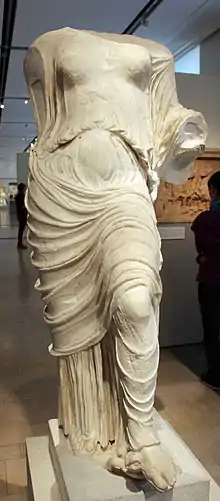Aphrodite Urania
Aphrodite Urania (Ancient Greek: Ἀφροδίτη Οὐρανία, romanized: Aphrodítē Ouranía) was an epithet of the Greek goddess Aphrodite, signifying "heavenly" or "spiritual", to distinguish her from her more earthly aspect of Aphrodite Pandemos, "Aphrodite for all the people".[2] The two were used (mostly in literature) to differentiate the more "celestial" love of body and soul from purely physical lust. Plato represented her as a daughter of the Greek god Uranus, conceived and born without a mother.[3][4] According to Hesiod, she was born from the severed genitals of Uranus and emerged from the sea foam.[5]


Pandemos was originally an extension of the idea of the goddess of family and city life to include the whole people, the political community. Hence the name was supposed to go back to the time of Theseus, the reputed author of the reorganization of Attica and its demes. Aphrodite Pandemos was held in equal regard with Urania; she was called σεμνή semni (holy), and was served by priestesses upon whom strict chastity was enjoined. In time, however, the meaning of the term underwent a change, probably due to the philosophers and moralists, by whom a radical distinction was drawn between Aphrodite Urania and Pandemos.
According to Plato, there are two Aphrodites, "the elder, having no mother, who is called the heavenly Aphrodite—she is the daughter of Uranus; the younger, who is the daughter of Zeus and Dione—her we call common." The same distinction is found in Xenophon's Symposium, although the author is doubtful whether there are two goddesses, or whether Urania and Pandemos are two names for the same goddess, just as Zeus, although one and the same, has many titles; but in any case, he says, the ritual of Urania is purer, more serious, than that of Pandemos. The same idea is expressed in the statement[6] that after Solon's time courtesans were put under the protection of Aphrodite Pandemos. But there is no doubt that the cult of Aphrodite was on the whole as pure as that of any other divinities, and although a distinction may have existed in later times between the goddess of legal marriage and the goddess of free love, these titles do not express the idea.
Etymology and names
According to Herodotus, the Arabs called this aspect of the goddess "Alitta" or "Alilat" (Ἀλίττα or Ἀλιλάτ).[7][8]
The most distinctively Western Asian title of the Greek Aphrodite is Urania, the Semitic "queen of the heavens". It has been explained by reference to the lunar character of the goddess, but more probably signifies "she whose seat is in heaven", whence she exercises her sway over the whole world—earth, sea, and air alike.
Worship
Her cult was first established in Cythera, probably in connection with the purple trade, and at Athens it is associated with the legendary Porphyrion, the purple king. At Thebes, Harmonia (who has been identified with Aphrodite herself) dedicated three statues, of Aphrodite Urania, Pandemos, and Apotrophia (Ἀφροδίτη Ἀποτροφία, Aphrodítē Apotrophía means "Aphrodite the Expeller", because in this role, she expels lust and evil desires from the hearts of men[9][10]).
Wine was not used in the libations offered to her.[11][12][13]
See also
Notes
- Pausanias: In the temple is the image of the goddess whom they call Ourania; it is made of ivory and gold and is the work of Pheidias; it stands with one foot upon a tortoise (the tortoise was a symbol of domestic modesty and chastity).
- Schmitz, Leonhard (1870). . In Smith, William (ed.). Dictionary of Greek and Roman Biography and Mythology. 3. Little, Brown and Company. p. 1284.
- Plato, Symposium 180
- Xenophon, Symposium 8. § 9.
- Hesiod, Theogony 188–206
- quoted by Athenaeus, 569d, from Nicander of Colophon
- Herodotus, i. 131., iii. 8
- Schmitz, Leonhard (1870). . In Smith, William (ed.). Dictionary of Greek and Roman Biography and Mythology. 1. Little, Brown and Company. p. 132.
- Bell, Robert E. (1993). Women of Classical Mythology: A Biographical Dictionary. Oxford University Press. p. 58. ISBN 9780195079777. Retrieved 8 April 2018.
- Gardner, Rev. James (2003). Encyclopaedia: Aa-gyro, Volume 1 of Encyclopaedia: Religions of the World, in Two Volumes, Rev. James Gardner. Indian Publishers Distributors. p. 154. ISBN 9788173413087.
- Scholiast, ad Soph. Oed. Col. 101
- Herodotus, i. 105
- Suda, s.v. νηφάλια
- Freese, John Henry (1911). . In Chisholm, Hugh (ed.). Encyclopædia Britannica. 2 (11th ed.). Cambridge University Press. p. 167.
External links
| Wikimedia Commons has media related to Aphrodite Urania. |